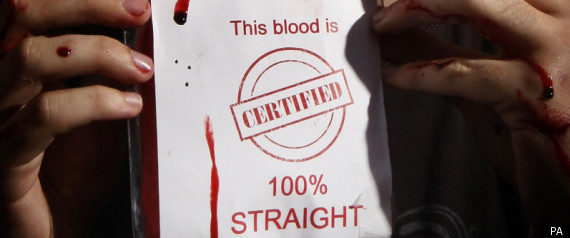America’s Homophobic Blood (Opinion)

Via Tharunka
December 11, 2018
I remember my first time donating blood very clearly: I waited in the gym of Forest Grove High School until I got summoned by kind Red Cross volunteers to fill out a questionnaire, have my blood tested for diseases, and finally donate. The process was simple, and I got to give myself a pat on the back at the end of it for doing something to save the lives of others. The Red Cross continued to call me, asking if I’d donate blood again, and I was more than willing to; sure, their constant phone calls were annoying, but the company wasn’t inherently bad, right? It turns out that The Red Cross, along with the Center for Disease Control (CDC) and the Food and Drug Administration (FDA) have been fierce advocates for anti-gay policies since the AIDS epidemic of the 1980s. For years, it was required that to give blood, a male donor could not have had sexual contact with another man since 1977— a lifetime ban for sexually active gay and bisexual men.
Although the magnitude of the HIV/AIDS crisis granted the CDC, FDA, and blood donation organizations plenty of reason to fear the infection of their blood supply, there is no reason today for such a ban. The day that I donated blood, immediately, before I had time to step in the donation room, the Red Cross tested me for a variety of blood-borne diseases, but most importantly HIV/AIDS. If I was granted the right to have my blood tested, why are gay men turned away before they have the chance to be screened? AIDS doesn’t exist solely in the blood of gay men; anybody can be infected with HIV, through needle use, breastfeeding, birth, or unprotected sex regardless of the participants’ gender.
Prior to 1983, the year that gay men were banned from donating blood, AIDS had been branded as a disease that only men who had engaged in intercourse with other men could get. Gay men were banned from donating blood if they had intercourse with another man since 1977 in the year 1985— 33 years ago. By the mid-80s though, it had been confirmed that there were various ways in which an individual could contract HIV. In the 30 years since this was confirmed, the United States has barely budged on their anti-gay blood donation policies. Now, according to The Red Cross, “A first time donor, whose last MSM [male having sex with male] contact was greater than 12 months ago, may be eligible to donate blood,” which makes absolutely no sense considering their admittance that there is only a two week window between HIV infection and its ability to be detected. Now, this isn’t necessarily the fault of the Red Cross, they don’t control government regulations, but as one of America’s biggest blood banks (the profitability of blood is also problematic, but that is another story), they have a lot of lobbying power. The fear should be nonexistent by 2018— “the current risk of contracting HIV from a blood transfusion is less than 1 in 1.5 million blood units, according to the National Institutes of Health.”

This ban shows more about our national discrimination against members of the LGBT+ community as well as our stigmatization of HIV/AIDS than our national concern for safety and disease control. By allowing this to happen, we are spreading a dangerous anti-gay rhetoric. If the United States was truly concerned about the safety and cleanliness of our blood banks, we would simply continue to practice virus and disease testing on each blood donor rather than singling out an entire demographic that is solely based in “a historic pattern of homophobia that connects identity to HIV and not behaviors.” Homophobia is inherently rooted in our country’s decision to ban blood simply due to sexuality.
As colleges, churches, community centers, and high schools across the country, including our own, continue to put on blood drives each and every year, I can’t help but question the justness of supporting a blatently homophobic system. There is absolutely nothing dangerous, nothing scary, about allowing gay men to donate blood. Regardless, it is obviously a necessity to have blood donated, since 4.5 million Americans will a need blood transfusion each year: what can somebody do to protest the homophobia of our blood donation structure while still aiding in the blood supply for so many people in need? Instead of donating to a blood bank that does little to advocate for gay rights (such as the Red Cross), there are blood banks that are actively researching and lobbying for gay inclusion. The New York Blood Center is a great example of this, yet New York is a bit far away from home. Unfortunately, all blood donation centers within 100 miles of Forest Grove High School are Red Cross banks. This doesn’t mean you shouldn’t donate blood, but supporting organizations that are advocating for LGBT+ rights while also engaging in meaningful conversation about the inherent homophobia in our institutions is an essential step in making a change.






















































































































































Siobhan Hayes • Mar 7, 2019 at 5:29 pm
This is so well done, Harley. You put in the perfect amount of outside knowledge as well as opinion. Loved reading it!
Morganne Peters • Dec 11, 2018 at 10:20 am
This article has got me FIRED-UP, love it. Well done.
Jennifer Campos • Dec 11, 2018 at 10:15 am
This article is very informative and can really be eye opening for a lot of other people and 100% love everything about it.
Reed • Dec 11, 2018 at 10:13 am
I like how you addressed the moral dilemma of wanting to save lives through donation while having a hesitancy to support a historically oppressive company like the Red Cross
Dulce Solis Hernandez • Dec 11, 2018 at 10:12 am
I had no idea that the Red-Cross did things such as this and so i thank you for talking about it and informing people who aren’t aware. This is a very well written article!
Alondra Pineda • Dec 11, 2018 at 10:10 am
I really liked how you brought awareness to this subject as a lot of people don’t know about it. I also really liked how committed you were to make an end to this. Good Job!
Micaela Gaither • Dec 11, 2018 at 10:08 am
This was really good. I loved your title.